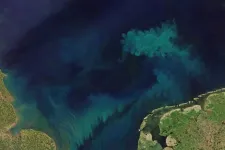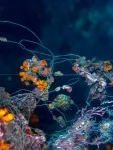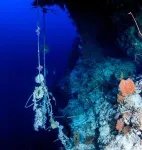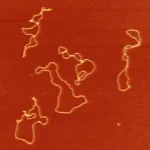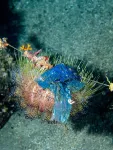(Press-News.org) CAMBRIDGE, MA -- The ocean’s color has changed significantly over the last 20 years, and the global trend is likely a consequence of human-induced climate change, report scientists at MIT, the National Oceanography Center in the U.K., and elsewhere.
In a study appearing today in Nature, the team writes that they have detected changes in ocean color over the past two decades that cannot be explained by natural, year-to-year variability alone. These color shifts, though subtle to the human eye, have occurred over 56 percent of the world’s oceans — an expanse that is larger than the total land area on Earth.
In particular, the researchers found that tropical ocean regions near the equator have become steadily greener over time. The shift in ocean color indicates that ecosystems within the surface ocean must also be changing, as the color of the ocean is a literal reflection of the organisms and materials in its waters.
At this point, the researchers cannot say how exactly marine ecosystems are changing to reflect the shifting color. But they are pretty sure of one thing: Human-induced climate change is likely the driver.
“I’ve been running simulations that have been telling me for years that these changes in ocean color are going to happen,” says study co-author Stephanie Dutkiewicz, senior research scientist in MIT’s Department of Earth, Atmospheric and Planetary Sciences and the Center for Global Change Science. “To actually see it happening for real is not surprising, but frightening. And these changes are consistent with man-induced changes to our climate.”
“This gives additional evidence of how human activities are affecting life on Earth over a huge spatial extent,” adds lead author B. B. Cael PhD ’19 of the National Oceanography Center in Southampton, U.K. “It’s another way that humans are affecting the biosphere.”
The study’s co-authors also include Stephanie Henson of the National Oceanography Center, Kelsey Bisson at Oregon State University, and Emmanuel Boss of the University of Maine.
Above the noise
The ocean’s color is a visual product of whatever lies within its upper layers. Generally, waters that are deep blue reflect very little life, whereas greener waters indicate the presence of ecosystems, and mainly phytoplankton — plant-like microbes that are abundant in upper ocean and that contain the green pigment chlorophyll. The pigment helps plankton harvest sunlight, which they use to capture carbon dioxide from the atmosphere and convert it into sugars.
Phytoplankton are the foundation of the marine food web that sustains progressively more complex organisms, on up to krill, fish, and seabirds and marine mammals. Phytoplankton are also a powerful muscle in the ocean’s ability to capture and store carbon dioxide. Scientists are therefore keen to monitor phytoplankton across the surface oceans and to see how these essential communities might respond to climate change. To do so, scientists have tracked changes in chlorophyll, based on the ratio of how much blue versus green light is reflected from the ocean surface, which can be monitored from space
But around a decade ago, Henson, who is a co-author of the current study, published a paper with others, which showed that, if scientists were tracking chlorophyll alone, it would take at least 30 years of continuous monitoring to detect any trend that was driven specifically by climate change. The reason, the team argued, was that the large, natural variations in chlorophyll from year to year would overwhelm any anthropogenic influence on chlorophyll concentrations. It would therefore take several decades to pick out a meaningful, climate-change-driven signal amid the normal noise.
In 2019, Dutkiewicz and her colleagues published a separate paper, showing through a new model that the natural variation in other ocean colors is much smaller compared to that of chlorophyll. Therefore, any signal of climate-change-driven changes should be easier to detect over the smaller, normal variations of other ocean colors. They predicted that such changes should be apparent within 20, rather than 30 years of monitoring.
“So I thought, doesn’t it make sense to look for a trend in all these other colors, rather than in chlorophyll alone?” Cael says. “It’s worth looking at the whole spectrum, rather than just trying to estimate one number from bits of the spectrum.”
The power of seven
In the current study, Cael and the team analyzed measurements of ocean color taken by the Moderate Resolution Imaging Spectroradiometer (MODIS) aboard the Aqua satellite, which has been monitoring ocean color for 21 years. MODIS takes measurements in seven visible wavelengths, including the two colors researchers traditionally use to estimate chlorophyll.
The differences in color that the satellite picks up are too subtle for human eyes to differentiate. Much of the ocean appears blue to our eye, whereas the true color may contain a mix of subtler wavelengths, from blue to green and even red.
Cael carried out a statistical analysis using all seven ocean colors measured by the satellite from 2002 to 2022 together. He first looked at how much the seven colors changed from region to region during a given year, which gave him an idea of their natural variations. He then zoomed out to see how these annual variations in ocean color changed over a longer stretch of two decades. This analysis turned up a clear trend, above the normal year-to-year variability.
To see whether this trend is related to climate change, he then looked to Dutkiewicz’s model from 2019. This model simulated the Earth’s oceans under two scenarios: one with the addition of greenhouse gases, and the other without it. The greenhouse-gas model predicted that a significant trend should show up within 20 years and that this trend should cause changes to ocean color in about 50 percent of the world’s surface oceans — almost exactly what Cael found in his analysis of real-world satellite data.
“This suggests that the trends we observe are not a random variation in the Earth system,” Cael says. “This is consistent with anthropogenic climate change.”
The team’s results show that monitoring ocean colors beyond chlorophyll could give scientists a clearer, faster way to detect climate-change-driven changes to marine ecosystems.
“The color of the oceans has changed,” Dutkiewicz says. “And we can’t say how. But we can say that changes in color reflect changes in plankton communities, that will impact everything that feeds on plankton. It will also change how much the ocean will take up carbon, because different types of plankton have different abilities to do that. So, we hope people take this seriously. It’s not only models that are predicting these changes will happen. We can now see it happening, and the ocean is changing.”
###
This research was supported, in part, by NASA.
END
Study: The ocean’s color is changing as a consequence of climate change
The color changes reflect significant shifts in essential marine ecosystems.
2023-07-12
ELSE PRESS RELEASES FROM THIS DATE:
DNA element with a murky past is borrowing cell’s repair machinery
2023-07-12
Like its viral cousins, a somewhat parasitic DNA sequence called a retrotransposon has been found borrowing the cell’s own machinery to achieve its goals.
In a new work appearing online Wednesday in the journal Nature, a Duke University team has determined that retrotransposons hijack a little-known piece of the cell’s DNA repair function to close themselves into a ring-like shape and then create a matching double strand.
The finding upends 40 years of conventional wisdom saying these rings were just a useless by-product of bad gene copying. It may also offer new insights into cancer, viral infections and immune responses.
Retrotransposons are segments ...
Plastic pollution on coral reefs increases with depth and mostly comes from fishing activities, Nature study finds
2023-07-12
SAN FRANCISCO, CA (July 12, 2023) — In a paper published today in Nature, researchers from the California Academy of Sciences, University of São Paulo, University of Oxford, University of Exeter, and other collaborators reveal the extent of plastic pollution on coral reefs, finding that debris increases with depth, largely stems from fishing activities, and is correlated with proximity to marine protected areas.
Through underwater visual surveys spanning more than two dozen locations across the Indian, Pacific, and Atlantic ...
Mast cells as a sensor: Enigmatic immune cells help to avoid harmful allergens
2023-07-12
The function of mast cells, which are part of the immune system, is still a mystery. Scientists at the German Cancer Research Center (DKFZ) have now shown in mice: mast cells function as a sensor that signals the animals to avoid antigens, including harmful allergens, and thereby protect themselves from health-threatening inflammatory reactions. The findings were published in the journal Nature.
Mast cells are found primarily in tissues that separate the outside and inside worlds of the body, such ...
Detailed map of the heart provides new insights into cardiac health and disease
2023-07-12
In a new study, published today (12 July) in Nature, researchers have produced the most detailed and comprehensive human Heart Cell Atlas to date, including the specialised tissue of the cardiac conduction system - where the heartbeat originates.
The multi-centre team is led by the Wellcome Sanger Institute and the National Heart and Lung Institute at Imperial College London, and has also presented a new drug-repurposing computational tool called Drug2cell, which can provide insights into the effects of drugs on heart rate.
This study is part of the international Human Cell Atlas* ...
Second year of COVID pandemic brought spike in child mental health visits to ED
2023-07-12
The number of young people in the United States visiting hospital emergency departments for mental health crises increased sharply during the second year of the COVID-19 pandemic, according to a study led by researchers from the Department of Health Care Policy in the Blavatnik Institute at Harvard Medical School. The findings are published Jul 12 in JAMA Psychiatry.
These results come amidst growing national concern about a crisis in youth mental health and provide important new details about how young people with mental health problems such as self-harm ...
Global study details microplastics contamination in lakes and reservoirs
2023-07-12
LAWRENCE, Kan. — Around 14 million tons of plastic end up in the ocean every year. But that is not the only water source where plastic represents a significant intrusion.
“We found microplastics in every lake we sampled,” said Ted Harris, associate research professor for the Kansas Biological Survey & Center for Ecological Research at the University of Kansas.
“Some of these lakes you think of as clear, beautiful vacation spots. But we discovered such places to be perfect examples of the link between plastics and humans.”
Harris ...
A foundation that fits just right gives superconducting nickelates a boost
2023-07-12
Researchers at the Department of Energy’s SLAC National Accelerator Laboratory and Stanford University say they’ve found a way to make thin films of an exciting new nickel oxide superconductor that are free of extended defects.
Not only does this improve the material’s ability to conduct electricity with no loss, they said, but it also allows them to discover its true nature and properties, both in and out of the superconducting state, for the first time.
Their first look at a superconducting nickel oxide, or nickelate, that does ...
New study using human fibroid cells supports use of green tea compound as treatment for uterine fibroids
2023-07-12
In a pre-clinical, proof-of-concept study from Johns Hopkins Medicine, researchers found that epigallocatechin gallate (EGCG), a green tea compound with powerful antioxidant properties, could be promising for both treating and preventing uterine fibroids. Results of the study, first posted online May 25 in Scientific Reports, add to growing evidence that EGCG may reduce fibroid cell growth. The study was specifically designed to identify the biochemical mechanisms responsible for EGCG action in fibroid cells.
The investigators emphasize that their study involves human fibroid cells grown in the laboratory and treated with EGCG extract to explore the possibility of oral EGCG supplementation ...
The good advice that could lift people out of poverty
2023-07-12
Providing access to housing, debt, and benefit advice within food banks could help lift people out of poverty - according to a University of East Anglia study.
Researchers worked with Norwich Foodbank centres, part of the Trussell Trust, on a pilot project that saw representatives from Citizens Advice and Shelter posted within the service.
The ‘Making a Difference’ initiative meant that people forced to use a food bank were also able to access advice on a range of issues - from housing and debt to benefits.
It is now hoped that this scheme will be rolled out to foodbanks nationally.
Lead researcher Dr Sarah Hanson, from UEA’s School of ...
Amplified Sciences receives $400,000 NCI grant to improve early detection of pancreatic cancer
2023-07-12
WEST LAFAYETTE, Ind. – Health care providers and their patients could know with greater confidence whether pancreatic cysts are benign or potentially malignant, and if surgery is required to remove them, by using a new diagnostic test currently in development.
Amplified Sciences, a clinical-stage life sciences diagnostic company that licenses Purdue University innovations, has received a Phase I Small Business Innovation Research, or SBIR, grant of approximately $400,000 from the National Cancer Institute (NCI) to develop the test. The company focuses on accurately detecting and categorically assessing the risks of debilitating ...
LAST 30 PRESS RELEASES:
For teens, any cannabis use may have impact on emotional health, academic performance
School meals could unlock major gains for human and planetary health
Menopause hormone therapy does not appear to impact dementia risk
Signature patterns of brain activity may help predict recovery from traumatic brain injury
Dresden study uncovers new key mechanism in cancer cells
New species are now being discovered faster than ever before, study suggests
Cannabis-based products show limited short-term benefit for chronic pain, with increased risk of adverse effects
Cannabis products with more THC slightly reduce pain but cause more side effects
Clearing the brain of aging cells could aid epilepsy and reduce seizures
Brain injuries linked with potential risk of suicide, new study finds
New technique lights up where drugs go in the body, cell by cell
New study finds movement of fishing fleets can reveal shifts in marine ecosystems
Embargoed: New evidence points to potential treatment for vascular dementia
Study uncovers disrupted brain balance in alcohol dependence
Working in groups can help Republicans and Democrats agree on controversial content moderation online
Structural findings reveal how distinct GPCR ligands create different levels of activation
Anything-goes “anyons” may be at the root of surprising quantum experiments
UC review: Maximizing workplace opportunity for veterans
From generation to complex control: Metasurfaces make perfect vortex beams "within reach"
Thin-film lithium niobate-based detector: recent advances and perspectives
Exploring why some people may tend to persistently make bad choices
How cells balance their protein levels
Nirsevimab vs RSVpreF vaccine for RSV–related hospitalization in newborns
Effectiveness and impact of maternal RSV immunization and nirsevimab on medically attended RSV in US children
AI gives scientists a boost, but at the cost of too many mediocre papers
Next-generation vision model maps tree growth at sub-meter precision
Genes aren’t destiny for inherited blindness, study shows
MIT study: High-fat diets make liver cells more likely to become cancerous
Exposure to multiple fine particulate matter components and incident depression in the US Medicare population
Risk of burdensome health care spending over time in the US
[Press-News.org] Study: The ocean’s color is changing as a consequence of climate changeThe color changes reflect significant shifts in essential marine ecosystems.
